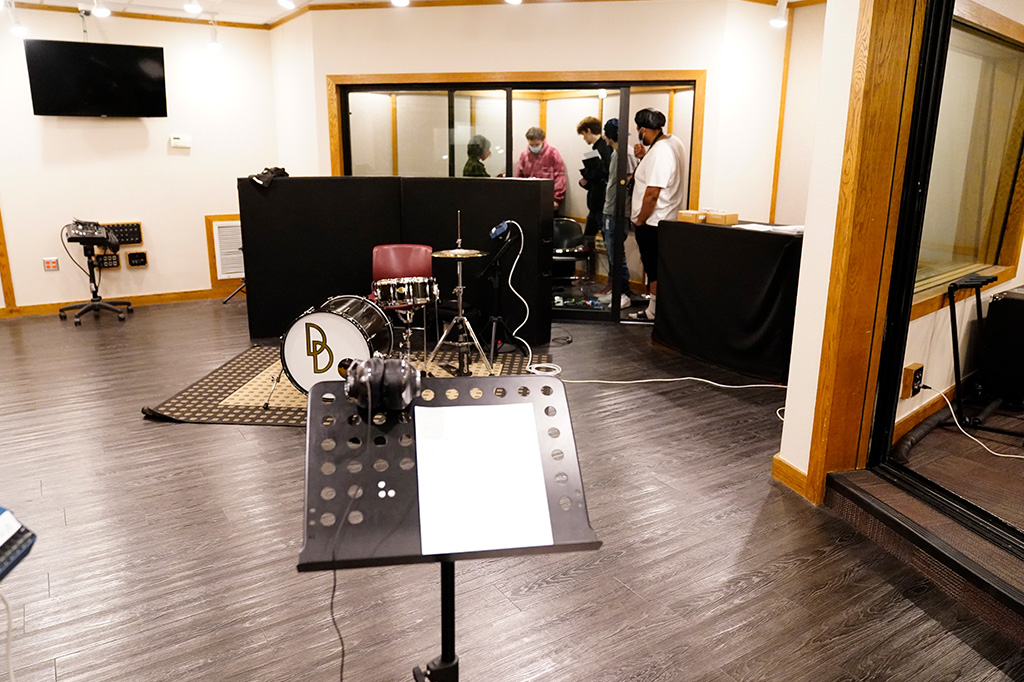Revengineering Series – Mixing a Kick Drum

“Revengineering” is defined by CRAS as reverse engineering – taking a sound and using engineering to bring it back to it’s simplest form.
CRAS Graduate and seven-time Grammy Award Winning engineer, Darrell Thorp, is hosting a series with CRAS where you can ask questions on topics we think Darrell could provide great feedback using “Revengineering”.
So let’s see the responses from Darrell on the first topic “Mixing a Kick Drum“:
CRAS Instructor Tony Nunes Introducing Darrell Thorp
Question #1 asked by Tyler – @007spacemonkey
When mixing kick drum, snare, or drums in general, how much do you use added samples? And when you do, is it hard to find the right sample to match the original drum kit. Also, what do you do with different velocity hits? Thank you very much.
Hello Tyler…
Thanks for your question.
I do use samples sometimes to replace kicks and snares. I really try hard not to rely on samples, but if you have a recorded kick drum that has a great top-end attack but not much chest or low end, adding a 808-style kick to enhance the low end is a great trick. I may in times just add samples to enhance the kick or the snare depending on what I feel is missing from the instrument I’m trying to enhance. There have been a few times where I find the choices for drums need to be completely replaced. And it does work if the part is simple enough to repair.
My favorite drum sampling program is Steven Slate Trigger. But there is also a cheaper one called Trigga (not Slate). With the Trigger (Slate) plug-in you can have several different samples on hand to mute and un-mute in the mix to find which sample works the best for the track. You can also tune the samples in real time. Once I have found a sample that I feel is working, I will print that on a new track and watch as the samples are printed so I know there are no missing or late hits.
Questions #2 asked by Jenna @therealjmc
What is your process for mixing the drums? Do you prefer to preserve the natural sound of the drums? Or do you blend it with, say, a compressed/processed copy?
Do you EQ kick drums?? Are you scooping out low end mud only or are you also doing any shaping? What frequencies do you apply these things to–generally? When you mix, how do you like to beef up the drum? Any tips on making the drums sound more punchy? Thanks, Jenna.
Hi Jenna
When mixing a kick drum I find that I have to use a lot of processing to get what I need for the foundation. But I am a big fan of parallel compression on all the drums in stereo. And sometime if needed I will add another mono parallel (just sending the Kick and Snare) using a different plug-in compressor altogether.
Also, on the parallel track I will use a combination of Compression and Tape Emulation. (GREAT TRICK)
Yes, I EQ a lot. BEEF can be added by using a plugin like Little Labs VOG, or Waves Big Bass. And there are several other great plug-ins out there that do this trick in different ways.
Punch to me is a combination of compression and EQ. Mostly Attack. A shelf at 8K adding sometimes 9-12 DB really helps a kick drum cut through the mix.
Question #3 asked by James @J_Stone_Beats
Hey Darrell, I don’t necessarily have any generic questions about mixing a kick drum, but I wanted to thank you for taking the time out to make your knowledge and experience available for others to learn from. Thanks man. – J Stone
James, thanks… That means a lot. This has been fun for me to think about how I work.
Question #4 asked by Kiko @bigkikoaudio
Drums buss in or out, gate eq (after/before), some ducking to bass? Favorite EQ for Kick.
Kiko…Hello I usually gate first, then compress, then EQ. I don’t duck the bass. Find that if the bass and kick are fighting at all I can scoop out a bit of low-mid 250 HZ to get the Kick and the Bass to play together.
Favorite EQ for drums… I love an API 550a. But also the SSL E series EQ is THE BOMB… Sometimes I get crazy and use both on the same instrument.
Question #5 asked by Colin @xpulsar
What sort of compression do you tend to use on kick drum, La3A, 1176, Distressor? Do you tend to use layers of different compression to achieve the sound your looking for, including parallel compression?
Hi Colin. Good question. Distressor, SSL and sometimes a DBX 160 are some of my favorite go to. I have layered different compression at times. One of my new favorites is made by Sound Radix. Its called the Drum Leveler. AMAZING…It’s a compressor, gate and leveler all in one. This plug-in can get really extreme.
I use the Drum Leveler in several ways. First is putting the plug-in right on the kick and then compressing/gating to get what I need. And the other is duplicating the kick track and making more of a THWACK channel where you compress and gate to the extreme just to get more punch and top attack. REALLY FUN.
Question #6 asked by Dee @dee4president
Hi Darrell. What are your go-to mics for kick and could you also tell us a little bit about your mic placement as well? Thanks
Hi Dee, GREAT GREAT question. My main kick drum mic of choice is a 47fet inside the drum, and a NS10 (or Sub Kick) on the outside. I find that I get what i need from this combination.
For placement, the 47FET inside is just slightly off-axis to where the beater hits. And I try and position the mic as far back to the front head of the drum as possible.
MY FAVORITE KICK DRUM SOUND is taking the front head off, putting a sand bag and a packing blanket inside the drum Obviously this is hard to achieve if the client is trying to get a double headed rumble sound.
Question #7 asked by Sal @sal.estrada
How do you make the kick drum and bass sit well together in a mix. They are both dominating the low end of the spectrum and sometimes can muddy things up what are some techniques that you use to make them play well together in the mix. -Thank you for your time, I’m a big fan of your work
Hi Estrada…
THANK YOU !!! So HONORED….
This is a very common question. But I always feel like people make a bigger deal out of it than it is. NOT Always. But Sometimes. Mud is your enemy in a mix. So if both the Kick and the Bass Guitar have a lot of MUD (200HZ-300HZ), they will fight. I usually never have to eq mud out of the bass. However, the KEY of the song I think can greatly effect how the Kick and the Bass work together. So I might scoop 250hz out of the bass. And if needed, I’ll take the same out of the Kick drum. But I really find that compressing the Bass HEAVILY (i.e. 10-15 db) helps keep the bass under control.
Especially if I am trying to push the bass really loud in a mix to give the song more weight and foundation.
Question #8 asked by Peyton
Hi Darrell,
I know you’re very adamant on hard pans. Would you ever hard pan a kick drum? I’ve tried several different ways and none were successful or sounded good yet. Would you use two separate channels and hard pan them accordingly? Would you layer the kick differently for a different effect on each ear?
Thanks,
Peyton M.
Hello Peyton.
I have never panned a kick drum… well, not that i can think of off the top of my head.
However, I can see how if you are working on EDM or a track this is mostly programmed then SURE… Might try using the same kick same on the left and right.
EQ them the same. But then take the kick on the left and pitch up a few cents, and the kick on the right pitch down a few cents. OR pan the kicks hard left and right and put a delay on both L and R and adjust the delay and chorus effect. GOOD LUCK !!! This could be a lot of fun.
Question #9 asked by Luis P
How often do you use, if at all, a 50Hz signal generator, noise gate and side chain to enhance the kick drum.
Hi Luis. Add a 50hz generator is a technique that I don’t use very often. Actually your question is making me think “WHY NOT”??? I am a big fan of adding samples that have the low end or the ring that I am looking for. And I have mentioned in other questions how I like to use Little Labs VOG or Waves BIG BASS.
Question #10 asked by JB @livernius
Do you track with particular mixing ideas in mind? How do you balance mid-range with the subby low-end? If and when you compress, are you mainly trying to shape the transient (front end and sustain) of the sound or are you first trying to control the level and get a consistent, steady pulse? Did you learn anything from Nigel Godrich re: the kick?
Hello JB… I learned a lot from Nigel. Unfortunately I can’t really talk about some of those things. However, I can talk about stuff that I have learned.
When I am tracking a project that I am going to mix, I am working very hard to make it sound “MIXED”. I am making decisions and shaping the sonic land scape constantly.
Its part of the fun.
In some cases I am trying to change the Transient. Mostly I am always looking for a tight kick drum that sits well in the mix and creates a good solid foundation to build the other instruments (especially the bass guitar). If this can be achieved with EQ, and Compression, then great. If I need to get in there and use more trickery and side chain, or parallel compress then I will.
Guess I am trying to get a steady pulse though the entire song.
This was a great first round of questions and answers for the Reveningeering Series.
Next week, we will be posting another question to be answered by Darrell for you to ask him about!

























